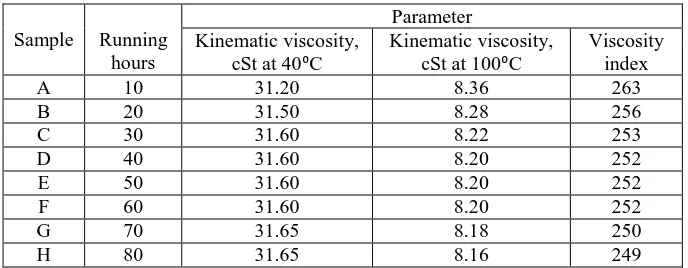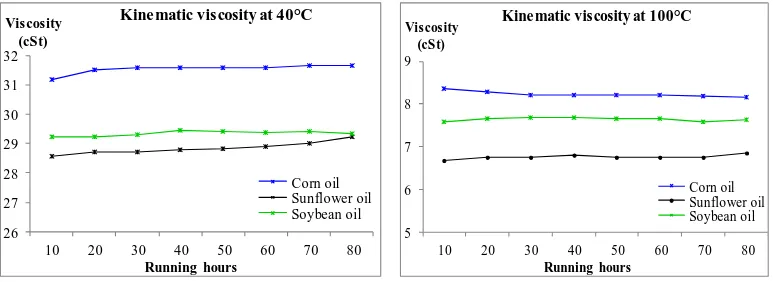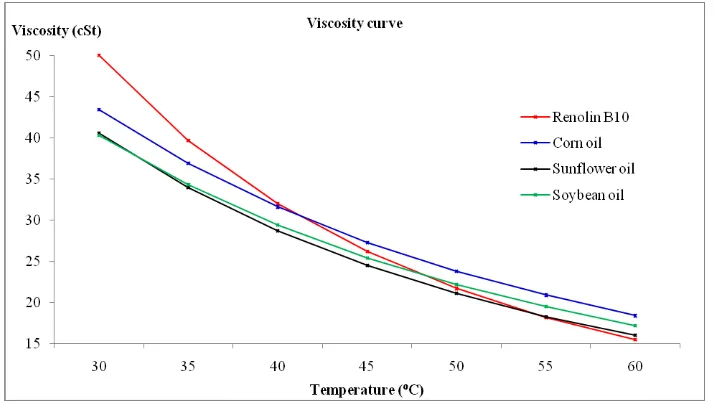Batu Pahat, Johor, 29 – 30 Oktober 2013
A STUDY OF VEGETABLE OILS AS A HELICAL GEAR
LUBRICANT
Ibrahim, A.1 and Ashikin, I.2
1
Faculty of Mechanical Engineering, Universiti Teknikal Malaysia Melaka, Durian Tunggal, 76100 Melaka, Malaysia
2
Universiti Tun Hussein Onn Malaysia, 86400 Parit Raja, Batu Pahat, Johor, Malaysia [email protected]
Advanced research on natural resource as a lubricant in transportation and industrial application is an interesting topic in green technology whereas the natural resources can be used to fulfill the demand and control the impact of human involved. Many researchers had been suggesting that vegetable oil has a potential as an alternative lubricant for engineering process although it has some disadvantages aspect such as poor or low temperature properties. The use of vegetable oils as a helical gear lubricant has not been studied before. This study is to analyse the performance of corn oil, sunflower oil and soybean oil as a helical gear lubricant. Oils sampling was taken periodically from the gear test rig within 80 running hours. The oil performance properties such as kinematic viscosity at 40⁰C and 100⁰C were measured using Brookfield LVDV-II with PRO digital programmable viscometer. Viscosity index for each oil sample was then calculated by using ASTM D2270 method. The experimental data will then be compared to the ideal performance of the synthetic gear lubricant. The finding shows that sunflower oil has good lubricant properties as compared to soybean and corn oil. Sunflower oil has good high temperature properties which is suitable for heavy duty gear application.
Keywords: Corn oil; sunflower oil; soybean oil; gear lubricant; gear test rig.
1. INTRODUCTION
The rapeseed oil also remained biodegradable and with low toxicity all over the service of lifetime (Remmele & Widmann, 1999). The performance studies of jojoba oil as a two- stroke engine lubricant. The findings show that the jojoba oil has great solubility with petrol and reduce the effects of wear but did increase in viscosity along service of time (Permsuwan et. al, 1996). The performances of vegetable oil based cutting fluids in a machining operation are studied by Bulleco & De Chiffre, 2001. Based on the previous studies, many researchers are focused in application of vegetable oils in machining process, machinery and engine lubricant. The study will be conducted using gear test rig is aim to get the evidence of vegetable oils performance in helical gear lubricant application.
2. METHODOLOGY
The machine used in the experimental testing is a gear test rig as shown in Fig. 1. Fig. 2 shows the helical gear used in the gear test rig. Firstly, 6 litres corn oil is added in oil compartment as a gear lubricant. Additional loading are given to the gear of 15kg to accelerate the gear lifespan. The gear test rig ran continuously with constant speed of 1200 rpm with corn oil as a lubricant. Eight samples with quantity of 125ml of corn oil have been taken every 10 running hours which the oil samplings are labelled with alphabet A to H. After eight corn oil samplings are taken, drained the oil compartment and replace the oil filter. Then, added 6 litres sunflower oil into oil compartment as a gear lubricant. Ran gear test rig with the same condition before. Eight sunflower oil samples of 125ml have been taken every 10 running hours and labelled with alphabet I to P. Drained the oil compartment and replace the oil filter. Lastly, 6 litres soybean oil is added in oil compartment as a gear lubricant. The gear test rig ran as well as condition before. Eight soybean oil samples of 125ml have been taken every 10 running hours and labelled with alphabet Q to X.
Batu Pahat, Johor, 29 – 30 Oktober 2013
The oil performance properties such as kinematic viscosity are measured instantly after oil samplings are taken using Brookfield LVDV-II with PRO digital programmable viscometer. The kinematic viscosity is expresses the ratio of the inertial forces to the viscous forces (Massey & Ward-Smith, 2011). The values of kinematic viscosity are measured in centistokes (cSt) unit at 40ºC and 100ºC by using ASTM D445-06 method. Viscosity index is a measurement for changes in viscosity respect to the temperature (Stachowiak & Batchelor, 2001). Viscosity index for each oil sample are then calculated by using ASTM D2270 method. All data measured then compared with synthetic SAE 75W gear lubricant brand of Renolin B10. Table 1 shows the composition of corn oil, sunflower oil and soybean oil.
Table 1. Composition of corn oil, sunflower oil and soybean oil (Ivanov et. al, 2010).
Corn oil Sunflower oil Soybean oil
Saturated fatty acids (%) 12.95 10.10 15.65
Monounsaturated fatty acids (%) 27.58 45.40 22.78
Polyunsaturated fatty acids (%) 54.68 40.10 57.74
Oleic acids (%) 28.00 45.30 24.00
Smoke point (⁰C) 232 227 238
3. RESULTS AND DISCUSSION
Results of the kinematic viscosity measured for corn oil, sunflower oil and soybean oil are shown in Table 2, Table 3 and Table 4 accordingly.
Table 2. Corn oil performance.
Table 3. Sunflower oil performance.
Table 4. Soybean oil performance.
Sample Running 100⁰C for corn oil, sunflower oil and soybean oil accordingly.
Batu Pahat, Johor, 29 – 30 Oktober 2013
Based on SAE gear oil viscosity classification shown in Fig. 5, the kinematic viscosities at 40⁰C lies in 75W class are from 23 to 52 cSt and the kinematic viscosities at 100⁰C lies in 75W class are from 4 up to 7 cSt. From the data measured, value of kinematic viscosities for corn oil at 40⁰C are from 31.20 to 31.65 cSt and kinematic viscosities at 100⁰C are between 8.16 and 8.36 cSt which are out of the 75W classification. The kinematic viscosities for soybean oil at 40⁰C are from 29.23 to 29.46 cSt and kinematic viscosities at 100⁰C are from 7.59 to 7.69 cSt which are also out of the 75W classification. While, the kinematic viscosities for sunflower oil at 40⁰C are from 28.57 to 29.23 cSt and kinematic viscosities at 100⁰C are between 6.67 and 6.85 cSt which are within the 75W classification.
Fig. 5. Viscosity classifications (SynLubeTM,1996).
index for the synthetic oil in Table 5 is Liqui Moly brand which is 185. Liqui Moly lubricant is used for high pressure gear oil for heavy-duty transmission which is more viscous at low and high temperature to prevent two moving surface from contact each other. There is no big deal about viscosity index value. In fact, the range of viscosity index for synthetic oil is between 80 and 400 (Hatschek, 1928).
Table 5. Synthetic SAE 75W-90 gear lubricant specification (Widmann, 2009).
Brand
Parameter Kinematic viscosity,
cSt at 40⁰C
Kinematic viscosity, cSt at 100⁰C
Viscosity index
Renolin B10 32 5.6 114
Liqui Moly 82 14.5 185
Redline 115 15.9 155
Mobil 115 16.4 144
Amsoil 120 15.7 140
Lucas 142 18.4 145
According to Fig. 5, the best gear lubricant viscosities range value within SAE 75W classification at 40⁰C is approximately 30 cSt and at 100⁰C is approximately 5 cSt. Based on these specifications, sunflower oil has nearly matched of this ideal lubricant performance which is having high potential as a helical gear lubricant application. The viscosities performance could be present in form of curve to shows the lubricant viscosities over temperature. Fig. 6 shows the graph of viscosity curve for vegetable oils compared to the synthetic gear lubricant Renolin B10.
Batu Pahat, Johor, 29 – 30 Oktober 2013
The vegetable oils and Renolin B10 have similar viscosity properties at high temperature but the vegetable oils have poor low temperature properties. At low temperature, sunflower oil and soybean oil has less viscous which is may affect the contact surface between two gears. The oil will allow the surface to contact each other and will result in increasing the friction and damage surface of gear will occur. This may result in decrease the gear lifetime in low temperature application. At high temperature, corn oil and soybean oil more viscous than Renolin B10. These oils would give better performance since it is thicker and give better separation of two moving surfaces but its require more energy for helical gear application at high temperature (Stachowiak & Batchelor, 2005). As overall view, the viscosity curve of sunflower oil has nearly similar to the viscosity curve of Renolin B10.
4. SUMMARY
The data of vegetable oils show low value of kinematic viscosities at 40⁰C but higher value of kinematic viscosities at 100⁰C with higher viscosity index range from 203 to 263. It shows that vegetable oils have much varies in viscosity over temperature range and have instability and poor temperature properties. From the findings, corn oil and soybean oil have more viscous at high temperature than synthetic oil and required more energy to the helical gear system. However, the corn oil can perform well at low temperature. Sunflower oils performances are adequate for helical gear lubricant application compared to the corn oil and soybean oil which is have similar lubricant performance to the synthetic gear lubricant and have properties within SAE 75W specification. This research will be further on to study the gear damage level by using sunflower oil as gear lubricant.
Acknowledgments
The financial support provided by Universiti Teknikal Malaysia Melaka, Centre For Research and Innovation Management (CRIM) as a short term grant (PJP/2012/FKM (30A)/S01033) under Sustainable Maintenance Engineering Research Group is gratefully acknowledged. The greatest appreciation goes to the Faculty of Mechanical Engineering laboratory personnel for their full cooperation.
References
ASTM D445-06: Standard Standard Test Method for Kinematic Viscosity of Transparent and Opaque Liquids (and Calculation of Dynamic Viscosity). ASTM D2270: Standard Practice for Calculating Viscosity Index From Kinematic
Viscosity at 40 and 100°C.
Belluco, W. & De Chiffre, L. (2001). Testing of Vegetable Based Cutting Fluids by Hole Making Operations. Lubricant Engineering 57(1): 12-16.
of Oxidation. Tribology International 40(7): 1035–1046. Hatschek, E. (1928). The Viscosity of Liquids. New York: Van Nostrand.
Ivanov, D. S.; Lević, J. D.; and Sredanović, S. A. (2010). Fatty Acid Composition of Various Soybean Products. Journal of the Institute for Food Technology in Novi Sad 37(2): 65–70.
Massey, B. S. & Ward-Smith A. J. (2011). Mechanics of Fluids (9th ed.). London; New York: Spon Press.
Permsuwan, A.; Picken, D. J.; Seare, K. D. R.; and Fox, M. F. (1996). Engine
Development and Test for Vegetable Oil Lubricant. International Journal of Ambient Energy 17(3): 157-161.
Remmele, E. & Widmann, B. (1999). Suitability and Environmental Compatibility of Rapeseed Oil Based Hydraulic Fluids for Agricultural Machinery. Journal of Synthetic Lubricant 16(2): 129-145.
Stachowiak, G. W. & Batchelor, A. W. (2001). Engineering Tribology (2nd ed.). Boston: Butterworth-Heinemann.
Stachowiak, G. W. & Batchelor, A. W. (2005). Engineering Tribology (3rd ed.). United Kingdom; Elsevier Inc.



